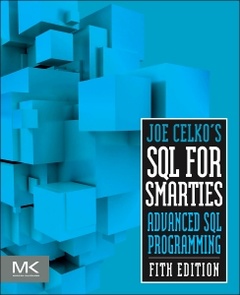Description
Joe Celko's SQL for Smarties (5th Ed.)
Advanced SQL Programming
The Morgan Kaufmann Series in Data Management Systems Series
Author: Celko Joe
Language: English
Subjects for Joe Celko's SQL for Smarties:
852 p. · 19x23.3 cm · Paperback
Description
/li>Contents
/li>Biography
/li>Comment
/li>
SQL for Smarties was hailed as the first book devoted explicitly to the advanced techniques needed to transform an experienced SQL programmer into an expert. Now, 20 years later and in its fifth edition, this classic reference still reigns supreme as the only book written by a SQL master that teaches programmers and practitioners to become SQL masters themselves! These are not just tips and techniques; also offered are the best solutions to old and new challenges. Joe Celko conveys the way you need to think in order to get the most out of SQL programming efforts for both correctness and performance.New to the fifth edition, Joe features new examples to reflect the ANSI/ISO Standards so anyone can use it. He also updates data element names to meet new ISO-11179 rules with the same experience-based teaching style that made the previous editions the classics they are today. You will learn new ways to write common queries, such as finding coverings, partitions, runs in data, auctions and inventory, relational divisions and so forth.SQL for Smarties explains some of the principles of SQL programming as well as the code. A new chapter discusses design flaws in DDL, such as attribute splitting, non-normal forum redundancies and tibbling. There is a look at the traditional acid versus base transaction models, now popular in NoSQL products. You?ll learn about computed columns and the DEFERRABLE options in constraints. An overview of the bi-temporal model is new to this edition and there is a longer discussion about descriptive statistic aggregate functions. The book finishes with an overview of SQL/PSM that is applicable to proprietary 4GL vendor extensions.
PART I : Data Declaration Features1. Databases versus File Systems2. Transactions and Concurrency Control3. Tables4. Keys, Exposed Physical Locators and Generated Values5. Normalization6. VIEWs and CTEs7. Auxiliary Tables and Views8. Other Schema Objects9. DDL Flaws to Avoid
PART II : Data Types10. Numeric Data in SQL11. Character Data Types in SQL12. Temporal Data Types in SQL13. Multiple Column Data Elements14. NULLs and 3-Valued Logic in SQL15. Table Administration Operations16. Set Operators
PART III Row and Column Level Features17. Comparison or Theta Operators18. Quantified Subquery Predicates19. BETWEEN and OVERLAPS Predicates20. CASE Expression Family21. LIKE and SIMILAR TO Predicates22. Simple One Table SELECT Statements23. Intermediate Aggregate Functions24. Descriptive Statistic Aggregate Functions25. OLAP Aggregate Functions26. JOINs
PART IV: Data Structures in SQL27. Graphs in SQL28. Trees and Hierarchies in SQL29. Queues and Lists30. Matrices in SQL
PART V: Typical Queries31. Coverings and Partitions32. Runs, Gaps, and Islands Rewrite or Expansion33. Inventory and Auction Models34. Relational Division35. Temporal Queries and Operations
PART VI: Implementation and Coding Issues36. Access Methods37. Basic Optimization Principles38. Overview of SQL/PSM
Mr. Celko is author a series of books on SQL and RDBMS for Elsevier/MKP. He is an independent consultant based in Austin, Texas.
He has written over 1200 columns in the computer trade and academic press, mostly dealing with data and databases.
- New to the 5th Edition:
- Overview of the bitemporal model
- Extended coverage of descriptive statistic aggregate functions
- New chapter covers flaws in DDL
- Examination of traditional acid versus base transaction models
- Reorganized to help you navigate related topics with ease
- Expert advice from a noted SQL authority and award-winning columnist Joe Celko, who served on the ANSI SQL standards committee for over a decade
- Teaches scores of advanced techniques that can be used with any product, in any SQL environment, whether it is SQL 92 or SQL 2011
- Offers tips for working around deficiencies and gives insight into real-world challenges




